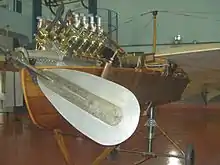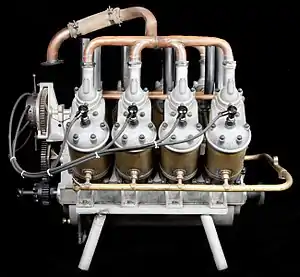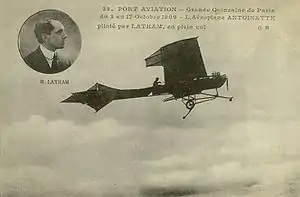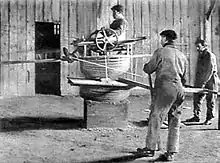Antoinette (manufacturer)
Antoinette was a French manufacturer of light petrol engines. Antoinette also became a pioneer-era builder of aeroplanes before World War I, most notably the record-breaking monoplanes flown by Hubert Latham and René Labouchère. Based in Puteaux, the Antoinette concern was in operation between 1903 and 1912. The company operated a flying school at Chalons for which it built one of the earliest flight simulators.



Private engine-building venture
Antoinette began as a private venture led by the engineer Léon Levavasseur and financed by Jules Gastambide, who owned an electricity generating station in Algeria. While on holiday with Gastambide and his family in 1902, Levavasseur expressed his interest in the emerging field of aviation and proposed the development of light, powerful engines for use in aircraft. Levavasseur then suggested to Gastambide's daughter, Antoinette, that the engines should be named after her.[2] Gastambide financed the venture. Levavasseur patented the V8 engine configuration that year.[3] By 1904, most of the prize-winning speedboats in Europe were powered with Antoinette engines.[2] During this time, he designed engines of various configurations of up to thirty-two cylinders.[4]
Antoinette incorporates
La Société Antoinette was incorporated in 1906, with Gastambide as president and Levavasseur as technical director. Aviation pioneer Louis Blériot was the vice-president .[2]
Antoinette displayed an automobile with a 7.2 L (439 cu in), 32 horsepower (24 kW) V8 engine in the 1906 Paris Salon de l'Automobile of that year.[5]
The company's primary business was the sale of engines to aircraft builders.[2] Their engines were used in the Santos-Dumont 14-bis of 1906, Paul Cornu's rudimentary helicopter of 1907, the Voisin biplane that was modified and piloted by Henri Farman who used it to complete Europe's first 1 kilometer circular flight in January 1908, and other significant pioneer aircraft.
The Farman-Voisin biplane was powered by a water-cooled Antoinette V8 engine which developed 50 horsepower (37 kW) at 1,400 rpm. It used an early form of manifold injection and weighed only 190 pounds in working order, including the water-filled cooling system. The engine block was cast aluminium, holding removable steel cylinders.[6] Levavasseur's Antoinette engines often included advanced features, including then called "direct petrol injection"[7] manifold injection,[8] and evaporative engine cooling.[9][10]
Aircraft manufacture
Levavasseur experimented with the construction of aircraft and in 1906 the Antoinette company was contracted to build an aircraft for Captain Ferdinand Ferber.[11] In 1908 Blériot tried to dissuade the directors of Antoinette from becoming aircraft manufacturers, fearing that they would begin competing against him for customers. Blériot left the company when his advice was ignored.[12]
Flying school at Châlons
In early 1909, the Antoinette company worked with the French Army at Camp Châlons near Mourmelon-le-Grand to establish the first military aircraft trials, a flight school and a workshop. The school included the Antoinette Trainer – a rudimentary flight simulator that comprised a half-barrel mounted on a universal joint, with flight controls, pulleys, and stub-wings (poles) to allow the pilot to maintain balance while instructors applied external forces.[13]

One of their earliest pupils was the adventurer Hubert Latham. Within months of learning to fly Latham became the company's principal instructor.[14] His pupils in 1909 included Marie Marvingt, who became the first woman to fly combat missions as a bomber pilot and established air ambulance services throughout the world,[15] and Infante Alfonso, Duke of Galliera, cousin of King Alfonso XIII of Spain and the first Spanish military pilot.[16]
Aircraft promotion with Latham


In the spring of 1909, Latham made several impressive flights.[17] This convinced Levavasseur that Latham could cross the English Channel in an Antoinette aircraft and win the Daily Mail prize for doing so.[18] Latham made two attempts to cross the English Channel in July 1909, both of which were unsuccessful due to engine failure while over the Channel. Between Latham's attempts, former Antoinette vice-president Blériot successfully crossed the Channel in his own aircraft[19][20] using a simpler and more reliable 25 hp (19 kW) air-cooled Anzani W3 engine[21][22] and a more efficient Chauvière propeller.[23]

Latham's efforts to promote Antoinette products were more successful at the Grande Semaine d'Aviation de la Champagne on 22–29 August 1909 at Reims, France, where he won the altitude prize, finished second in the speed competition, took third place in the Gordon Bennett Cup for aeroplanes, and, in the Grand Prix event, trying to fly the longest distance around the circuit in a single uninterrupted flight, he won second prize in one aircraft (an Antoinette IV) and fifth prize in another (an Antoinette VII).[24][25]

At the 1910 Gordon Bennett Trophy race at Belmont Park in the United States, Latham flew an Antoinette VII with a 100 horsepower (75 kW) V16 engine.[26]
Aircraft built by Antoinette
| Model name | First flight | Note |
|---|---|---|
| Antoinette I | Never flown. | |
| Antoinette II | February 1908 [27] | known as the Gastambide-Mengin II |
| Antoinette III | 1908 | A biplane designed by Ferdinand Ferber, also called the Ferber IX |
| Antoinette IV | 1908 | Single-engine one-seat monoplane with aft-mounted aileron surfaces |
| Antoinette V | 20 December 1908 | Variant of Antoinette IV with wing warping instead of ailerons |
| Antoinette VI | 1909 | Variant of Antoinette V with true ailerons (later converted to wing warping) |
| Antoinette VII | 1909 | Further development of Antoinette IV with larger engine and wing warping |
| Antoinette VIII | 1909 | Further development of Antoinette IV with larger engine and wing warping |
| Antoinette military monoplane | 1911 | Proposed military development of Antoinette IV |
Turbulent times and the end of Antoinette
Levavasseur left the Antoinette company in November 1909, shortly after Gastambide.[28] Gastambide and Levavasseur returned to the company in March 1910, Gastambide as president of the board and managing director and Lavavasseur as technical director.[29] After Levavasseur's return, he designed the Antoinette military monoplane, a streamlined monoplane with cantilever wings, which was ultimately rejected by the military.[30][31] The Antoinette company went bankrupt shortly afterward.[32]
References
Notes
- "Catalogo collezioni – Motore aeronauticoAntoinette – museoscienza". www.museoscienza.org. Retrieved 2016-05-10.
- Villard, Contact!, p.51
- Gerard, Les moteurs et aéroplanes Antoinette, p.2
- Gerard, Les moteurs et aéroplanes Antoinette, p.4
- Hemmings Motor News: Eight Is Enough
- The Aero Manual 1910 (1972 reprint ed.). Newton Abbot, Devon: Davis & Chrles Reprints. 1972 [1910]. p. 188. ISBN 978-0-7153-5512-1.
- Flight magazine, December 21, 1933, p1292: "Direct petrol injection"
- Richard van Basshuysen (ed.): Ottomotor mit Direkteinspritzung und Direkteinblasung: Ottokraftstoffe, Erdgas, Methan, Wasserstoff, 4. issue, Springer, Wiesbaden 2017. ISBN 9783658122157. p. 7
- "Power Planting", Flight: 249, March 19, 1942
- "Power Planting", Flight: 250, March 19, 1942
- Flight magazine, December 7, 1916, p.1075: Ten Years Ago "An Antoinette Aeroplane"
- Villard, Contact!, p.52
- Human Factors in Simulation and Training By Dennis A. Vincenzi, John A. Wise p18 with image
- Flight Magazine, December 1909, A Training 'class' at Chalons
- Lam, David M. (2004). "Marie Marvingt and the Development of Aeromedical Evacuation". Aviation, Space, and Environmental Medicine. Aerospace Medical Association. 74 (8): 863–8. PMID 12924762.
- Flight Magazine 21 October 1975 p246: Infante Alfonso
- Brett, R. Dallas, The History of British Aviation 1908–1914, p.26.
- King, Stephen H., The Passion That Left The Ground: The Remarkable Airplanes of Léon Levavasseur, p. 56-57.
- Flight Magazine 30 March 1951 p.365: Portrait of a Pioneer by Colin Boyle
- Flight Magazine 30 March 1951 p366: Portrait of a Pioneer by Colin Boyle
- Grant, Flight: 100 Years of Aviation, pp.42–43
- Flight Magazine July 31, 1909 p.456: "The Engine"
- Flight Magazine July 5, 1913 p.745
- Flight Magazine, September 4, 1909, p.536: Tabulated Performances, &c., of Rheims Meeting
- Nicolaou, Stéphane, Reims – 1909: Le Premier Meeting Aérien International, pp. 51ff."
- Gerard, Les moteurs et aéroplanes Antoinette, p.12
- Opdycke 1990, p.20
- Flight magazine, November 13, 1909: Aviation News of the Week "M. Levavasseur Retires from Antoinette Co."
- Flight magazine, March 19, 1910: "M. Levavasseur Rejoins The Antoinette Co."
- Flight magazine, May 14, 1942, p.476: Modernity in 1911
- Flight magazine, May 14, 1942, p.477
- Villard, Contact!, p.53
Bibliography
- Hartmann, Gerard (2007-08-05). "Les moteurs et aéroplanes Antoinette" [Antoinette engines and aeroplanes] (PDF) (in French). Archived from the original (PDF) on 2014-12-14. Retrieved 2009-11-08.
- Grant, R.G (2004). Flight: 100 Years of Aviation. London: Dorling Kindersley. ISBN 978-1-4053-0575-4.
- King, Stephen H. (2007). The Passion That Left The Ground: The Remarkable Airplanes of Léon Levavasseur. Tarentum, Pennsylvania: Word Association Publishers. ISBN 978-1-59571-178-6.
- Nicolaou, Stéphane (1999). Reims - 1909: Le Premier Meeting Aérien International (in French). Le Bourget, France: Musée de l'Air et de l'Espace.
- Opdycke, Leonard E. (1999). French Aeroplanes before the Great War. Atglen, PA: Schiffer. ISBN 978-0-7643-0752-2.
- Villard, Henry Serrano (2002-01-01). Contact! The Story of the Early Aviators. Courier Dover Publications. ISBN 978-0-486-42327-2.
External links
 Media related to Antoinette (manufacturer) at Wikimedia Commons
Media related to Antoinette (manufacturer) at Wikimedia Commons- Antoinette monoplane (in French)
- Entry for the IV at impdb.org
